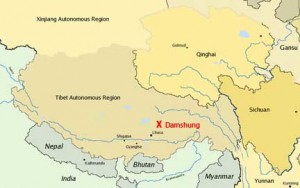 A major earthquake measuring 6.6. on the Richter scale struck Damshung (Chinese: Dangxiong) county in central Tibet on Tuesday (October 7), killing at least 10 people and injuring many more inside collapsed buildings.
A major earthquake measuring 6.6. on the Richter scale struck Damshung (Chinese: Dangxiong) county in central Tibet on Tuesday (October 7), killing at least 10 people and injuring many more inside collapsed buildings.
Lhasa was later affected by after-shocks, and many people left their houses to gather in a large crowd outside the Jokhang temple. Initial bulletins from China’s official news agency, Xinhua, reported that at least 30 people had been killed, but that figure was attributed to ‘unauthoritative sources’ and later scaled down. Further reports yesterday state there are thought to be no more people trapped under rubble, and that no further fatalities are expected.
Since the crackdown due to protests in Lhasa and beyond began in March, it has become extremely difficult for non-governmental organizations to function in the Tibet Autonomous Region, meaning that immediate assistance from these organizations was not possible.
One report from the region said most of the dead and injured in the earthquake, which struck at 4.30 in the afternoon local time on October 7, were women, children and the elderly who had been working indoors when the quake struck, while men had mostly been gathering winter fodder for livestock. Another report said Buddhist lamas are traveling to the scene to conduct prayer services for those who had died.
The Dalai Lama issued a statement from Dharamsala yesterday, saying: “I am deeply saddened by the loss of life and property as a result of the earthquake that struck Damshung county and neighboring areas west of Lhasa on Monday. Our prayers go out to those who have lost their lives in this tragedy and offer condolences to their families and those affected by this natural disaster.” The Dalai Lama also said in his statement, “I am exploring avenues to extend assistance as a token of my deep concern and solidarity with the people devastated by these earthquakes.”
A tremor shook Lhasa for around 30 seconds afterwards. Schools were closed, and frightened residents gathered at the Jokhang temple. A Tibetan source said: “Since March, not many people have been seen on the streets of Lhasa due to the crackdown. So it was unusual to have such a large gathering of people. The authorities were quite nervous about the security implications even despite the earthquake.”
The initial quake in Damshung, around 50 miles north of Lhasa, was followed 15 minutes later by a smaller one to the west of Lhasa, according to the US Geological Survey. A large aftershock measuring 5.2 on the Richter scale hit Damshung at 8:10 of the same evening measuring, one of a total 15 aftershocks so far.
According to official reports People’s Liberation Army (PLA) troops stationed in Lhasa are leading rescue efforts, as well as hundreds of disaster relief workers once a road to the village had been repaired, providing food, water, tents and sanitation for the victims.
Official accounts from the village at the epicenter of the earthquake, Yangyi village, recount how around 170 buildings collapsed in the first earthquake at 4:30, killing nine people and seriously injuring 11 more, while a further 19 needed treatment for minor injuries.
Another fatality was reported in Nagarze (Ch: Liangkaze) county in Lhokha (Ch: Shannan) prefecture, when a teenager was killed and 15 other students injured as they panicked while trying to evacuate their school during the earthquake.
One of the most devastating features of the huge earthquake that struck Sichuan province on May 12 of this year, killing 79,000 people, was that many school buildings collapsed instantly, killing and injuring thousands of children. The school buildings had been poorly constructed with inferior materials as a result of under-funding and corruption; one official report on the Damshung earthquake stated: “Tibet’s regional government decided Monday night to close all schools in Lhasa on Tuesday due to safety concerns.”
The official media also reported that the earthquake did not affect the running of the Qinghai-Tibet railway, which passes through Damshung county. The railway was engineered to withstand, as far as possible, seasonal movements in the ground caused by the freezing and thawing of the soil, as well as a certain degree of seismic activity. However, leading scientists have warned that global warming may render the railway so unstable as to be too dangerous to use within 10 years. In addition, much of the route of the railway passes through areas prone to significant seismic activity. The Kunlun Mountain range which the railway crosses to the north of Damshung county was struck by an earthquake measuring 8.1 on the Richter scale in 2001, five years before the railway was completed. (See ICT report, ‘Tracking the Steel Dragon‘).

